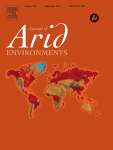View Item
- xmlui.general.dspace_homeCentros Regionales y EEAsCentro Regional Patagonia SurEEA Santa CruzArtículos científicosxmlui.ArtifactBrowser.ItemViewer.trail
- DSpace Home
- Centros Regionales y EEAs
- Centro Regional Patagonia Sur
- EEA Santa Cruz
- Artículos científicos
- View Item
Soil respiration in Patagonian semiarid grasslands under contrasting environmental and use conditions
Abstract
Grasslands comprise 85% of Southern Patagonia land area and play a critical role in the global carbon
cycle. We evaluated seasonal dynamics to identify differences in soil respiration rates between contrasting
grasslands across a climate gradient (rainfall), long term grazing intensity (moderate and high
stocking rates) and land uses (silvopastoral system, primary forest and grassland). Soil respiration varied
from 0.09 g CO2 h 1 m 2 in winter to a
[ver mas...]
Grasslands comprise 85% of Southern Patagonia land area and play a critical role in the global carbon
cycle. We evaluated seasonal dynamics to identify differences in soil respiration rates between contrasting
grasslands across a climate gradient (rainfall), long term grazing intensity (moderate and high
stocking rates) and land uses (silvopastoral system, primary forest and grassland). Soil respiration varied
from 0.09 g CO2 h 1 m 2 in winter to a maximum of 1.43 g CO2 h 1 m 2 in spring. We found that the soil
respiration rate was 30% higher in moderately grazed grasslands than in heavily grazed grasslands. Landuse
changes showed that soil respiration followed the order silvopastoral system > native
forest > grassland. While almost all plant and soil variables had a significant effect on soil respiration, soil
carbon concentration, litter cover and depth and bare soil cover were the main factors explaining 78
e83% of the variance in soil respiration. Soil respiration rates were correlated strongly to air and soil
temperatures and to a lesser extent with mean monthly rainfall and soil volumetric water content. The
information provided in the present work about soil respiration is essential to estimate carbon balance
for a range of important and widespread ecosystems in Patagonia.
[Cerrar]

Fuente
Journal of arid environments 119 : 1-8. (August 2015)
Date
2015-08
Editorial
Elsevier
ISSN
0140-1963
Formato
pdf
Tipo de documento
artículo
Palabras Claves
Derechos de acceso
Restringido
 Excepto donde se diga explicitamente, este item se publica bajo la siguiente descripción: Creative Commons Attribution-NonCommercial-ShareAlike 2.5 Unported (CC BY-NC-SA 2.5)
Excepto donde se diga explicitamente, este item se publica bajo la siguiente descripción: Creative Commons Attribution-NonCommercial-ShareAlike 2.5 Unported (CC BY-NC-SA 2.5)

